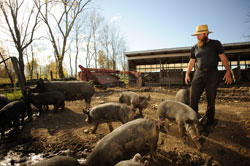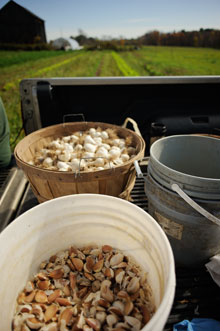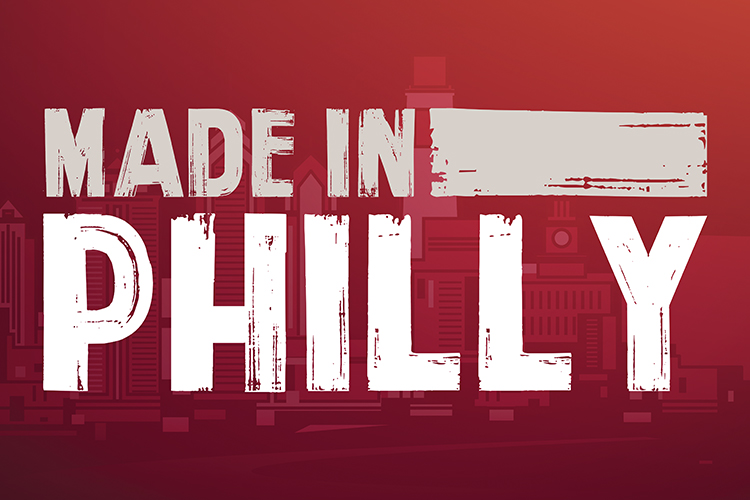 Sam and Brian FoxThough he and his brother, Sam, were raised on a conventional dairy farm in Northeastern Pennsylvania, Brian Fox took a completely different career path before realizing that he’d rather be farming. Brian spent his days as a graphic designer in Washington, D.C., before delving full-time into tending vegetables and cultivating garlic. But ask him today what he thinks of swapping a desk job for this and it’s clear he made the right move: “I’d rather be this kind of worn-out.”
Sam and Brian FoxThough he and his brother, Sam, were raised on a conventional dairy farm in Northeastern Pennsylvania, Brian Fox took a completely different career path before realizing that he’d rather be farming. Brian spent his days as a graphic designer in Washington, D.C., before delving full-time into tending vegetables and cultivating garlic. But ask him today what he thinks of swapping a desk job for this and it’s clear he made the right move: “I’d rather be this kind of worn-out.”
 The brothers own Salem Mountain Farm in Waymart, Pennsylvania. Sam had always had the agricultural dream, but their parents ended the dairy operation in the 1970s. He and Brian knew that starting their own agricultural business, even if it was on the family land, was going to be a challenge.
The brothers own Salem Mountain Farm in Waymart, Pennsylvania. Sam had always had the agricultural dream, but their parents ended the dairy operation in the 1970s. He and Brian knew that starting their own agricultural business, even if it was on the family land, was going to be a challenge.
“We didn’t want to take on debt to start the farm,” says Sam, whose family includes three young children. “If I was by myself, or if it were just my wife and I, it would be different. But when you have a couple kids, you need to have the steady income.” Though Sam and his family live on a property down the road from the farm, he works a day job at a Walmart distribution center. When people ask why he doesn’t just “go farm,” he brings up the unpredictability aspect. “We could have a rainstorm and lose everything, and then what do I do?” In the meantime, Sam bides his time farming on weekends, hoping that at some point he’ll be able to focus on farming full-time.
Brian, too, has worn two hats. From 2005 through 2007, for the first several seasons of their fledgling agricultural operation, he continued to work as a graphic designer in Washington, D.C. Every Thursday night during the season, he would drive 4.5 hours from the city to the farm. “Friday, Saturday and Sunday, we’d slam in 2,500 bales of hay, I’d jump in the car at 8 p.m., drive back to D.C. and recover at my desk job,” he says. In 2008, the brothers bought their beef cattle and Brian transitioned into full-time farming, although he still moonlights as a graphic designer in the off season.
 Brian and Sam are definitely still working long hours, but they’ve made an investment in those early days that is now paying off.
Brian and Sam are definitely still working long hours, but they’ve made an investment in those early days that is now paying off.
When they started, they began with planting a few hundred dollars’ worth of garlic, a crop that’s relatively low-maintenance, but has high value at harvest time. In the beginning, Brian says they didn’t have any way to sell it, so they just kept replanting it. “Within three years, we were planting 500 pounds,” he says. That multiplication of an initial investment has been a good one. Even if they sell three-quarters of their finished garlic to a wholesaler, the remaining seed garlic would cost them about $7,000 if they had to buy it now. Currently, they sell most of their garlic to a wholeasaler in New York, but they’re looking into the possibility of making a value-added product with it—possibly pickled garlic.
Their lean, dynamic 115-acre farm also includes an array of vegetables, 40 acres of hay, grass-fed beef cattle, egg-laying hens and a few pigs. The brothers are still trying to hone in on their best business strategies. They do two farmers markets a week during the summer and one during the winter, and they’re toying with the idea of offering community supported agriculture (CSA) shares. The money they get for wholesaling the garlic gives them enough to keep farm operations going. “[But] we’re not quite rich yet,” Brian says, laughing, adding that it’s not about the money.
“You have to want to farm—honest to god, it is a vow of poverty,” he adds. “We’re not making tremendous money here, but we’re making enough to keep going. We’re pay-as-you-go, if we can’t pay for it now, we don’t do it.”
 Sam agrees that many new farmers convince themselves that they need more than they actually do. “[They’ll say] ‘If we only had a bigger tractor, we’d be able to make more money’ and that’s the lie that farmers get into.” (At Salem Mountain, the newest tractor is from 1976, and they paid cash for it just a few years ago.)
Sam agrees that many new farmers convince themselves that they need more than they actually do. “[They’ll say] ‘If we only had a bigger tractor, we’d be able to make more money’ and that’s the lie that farmers get into.” (At Salem Mountain, the newest tractor is from 1976, and they paid cash for it just a few years ago.)
Mostly, they’re trying to take the process one season at a time, and not get ahead of themselves. It’s a time of challenges, but also of possibility.
“You have to be an optimist to be a farmer or to be an entrepreneur,” Brian says. “The farm will take every bit of work and money you throw into it. … I usually say that I want to quit at nighttime, but in the morning I say, ‘Let’s do this.’”
Asked whether or not he misses the predictability of a day job, Brian laughs.
“I miss the paycheck,” he says. “But I don’t miss taking anybody’s bull—-, and the bull—- that I do deal with I can compost and put on the vegetables.”
Story by Emily Teel. Photos by Albert Yee.








